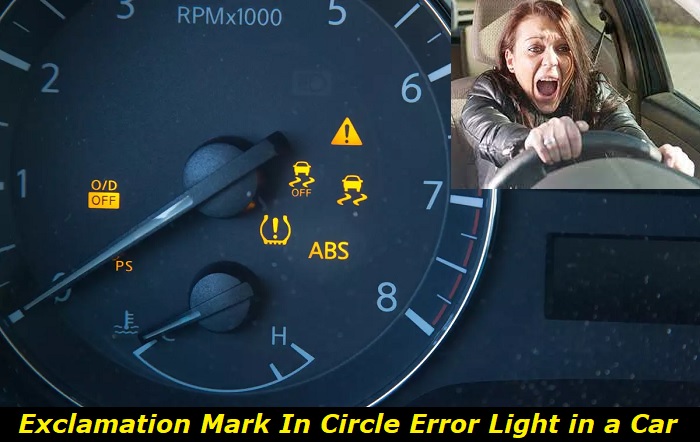Noticing a symbol on your dashboard that looks like a circle with an exclamation mark inside while driving can be confusing and worrying. Except, of course, you understand what it means and how to address it.
Circle light with exclamation mark inside highlights
- Common reasons:braking system problem, parking brake engaged, ABS issues
- How to fix:check parking brake, check brake fluid, have the car inspected
- Possible consequences:braking may lose efficiency
- Priority level:High
- Can you drive?Not recommended
- DIY repair:Impossible
- Repair price range:$250-$800

Why There is a Circle Symbol with Exclamation Mark Inside Your Car
Being aware of all the symbols and warning lights that may appear on your dashboard is critical when you're behind the wheel. Here are common reasons you might be seeing the circle symbol with an exclamation mark on your dashboard:
1) Malfunctioning brake system
One symbol that may catch your attention is the circle with an exclamation mark inside, often accompanied by the word "BRAKE." This sign is an indication that there is an issue with your vehicle's brake system, which could be anything from worn brake pads to low brake fluid levels.
Over time, the friction material on the pads wears down, reducing their effectiveness. This can lead to longer stopping distances and increased risk of accidents, so have worn brake pads replaced as soon as possible.
Another potential cause of the brake warning light is low brake fluid levels since the brake system relies on a certain amount of fluid to function properly. If you suspect that your brake fluid levels are low, check and top it off.
Note that if this warning light appears, it's not necessarily an indication of a major problem. It could be something as simple as a sensor issue or a brake fluid leak. However, it's still crucial to have your vehicle inspected by a professional as soon as possible to ensure your safety and identify the root of the problem.
2) Low tire pressure
Ever been driving down the road and suddenly noticed a little exclamation point inside of a half-circle light up on your dashboard? There's no need to panic! This symbol can simply mean that one or more of your tires is low on air pressure.
Many modern cars are equipped with a tire pressure monitoring system (TPMS) that alerts the driver when one or more tires are underinflated. This system uses sensors inside the tires to measure the air pressure and send a signal to the car's computer, which then displays the warning light on the dashboard.
While this little exclamation point may seem like a minor inconvenience, it is a very important safety feature. Underinflated tires can greatly increase the risk of a blowout or other tire failure while driving, which can lead to serious accidents or even fatalities.
So, what should you do when you see this light come on?
- The first step is to check the air pressure in all of your tires, including the spare. You can find the recommended air pressure for your tires in the owner's manual or on a sticker inside the driver's side door jamb. Use a tire gauge to check the pressure and add air as needed.
- If you find that one or more tires are consistently low on air pressure, this may be a sign of a leak or other problem with the tire. In this case, have the tire inspected and repaired by a professional as soon as possible.
The symbol may also come on when the temperature changes. Cold weather can cause the air inside your tires to contract, making them appear underinflated. In these cases, it is best to check the air pressure when the tires are warm and make any necessary adjustments.
3) Issues with the vehicle's transmission
The little exclamation point inside a circle may seem like a small detail on your dashboard, but it can hold a lot of important information about your vehicle's transmission. This warning light can indicate a range of issues, from temperature level to internal transmission failure.
One of the most common reasons the exclamation point light may turn on is due to a high-temperature level in the transmission. Factors, such as low transmission fluid, a clogged transmission filter, or even a faulty transmission cooler can cause this issue.
Another reason the exclamation point light may turn on is due to internal transmission failure resulting from worn gears, bearings, or even a faulty transmission control module.
Shift interlock problems can also cause the symbol to appear. A faulty shift interlock solenoid, which prevents the transmission from shifting out of the park without the brake pedal being depressed, can cause this issue.
Problems with torque converters caused by a variety of factors, such as worn bearings, or a clogged torque converter are another culprit.
Finally, the exclamation point light may turn on due to issues with the vehicle's valve body. This could be caused by a variety of factors, such as worn valves, a clogged valve body, or even a faulty valve body solenoid.
In a few other cases, you may see the symbol as a general maintenance reminder. This could be a reminder to have your transmission fluid checked or to have your transmission serviced. Take your vehicle to a mechanic as soon as possible to avoid further damage to the transmission.
Problems with torque converters caused by a variety of factors, such as worn bearings, or a clogged torque converter are another culprit.
Other Dashboard Warning Light Symbols to be Aware of
These symbols are designed to alert you to potential problems with your vehicle and can help you avoid costly repairs in the long run. However, many drivers are only familiar with the most common warning light symbols, such as the check engine light or the oil pressure warning light.
We'll take a look at some other warning light symbols that you should be aware of.
- Battery warning light
This symbol typically appears as a battery shape with a plus and minus sign inside. You should pay attention to this light, as it indicates that there may be a problem with your vehicle's charging system. A faulty alternator, a dead battery, or even a corroded battery cable can cause this.
- Coolant warning light
Next up is the coolant warning light which looks like a thermometer or a temperature gauge. If this light comes on, it means that there may be a problem with your vehicle's coolant system. Issues that can cause this include a leak in the coolant system, a faulty thermostat, or a clogged radiator. A lack of coolant can cause your engine to overheat and cause significant damage, so address this issue as soon as possible.
- Airbag Warning Light
This is usually a yellow or orange light that is located on your dashboard. This light is an indication that there may be a problem with the airbag system in your vehicle which is responsible for protecting you and your passengers in the event of a collision.
- Diesel Glow Plugs Active
This warning light is specific to diesel-powered vehicles and indicates that the diesel glow plugs, used to heat the air in the combustion chamber, are currently active and warming up. If this warning light appears and stays on after the engine starts, it may indicate a problem with the glow plugs or the glow plug control module.
- Low oil pressure
This symbol looks like an oil can with a drop of oil coming out of the spout. It indicates that the oil pressure in your engine is too low, which can cause serious damage if not addressed. If you see this symbol, pull over and turn off your engine as soon as possible. Check the oil level and add more if necessary. If the problem persists, seek professional help.
- Engine warning light
This symbol appears as an engine shape or a red exclamation point and often means that there may be a problem with your vehicle's engine. This could be caused by a variety of issues, such as low oil pressure, a malfunctioning sensor, or a problem with the emission control system.
Conclusion
The symbol of a circle with an exclamation mark inside often found on car dashboards is a warning indicator that alerts the driver to a potential malfunction or issue with the vehicle. Pay attention to this symbol and have your car checked by a mechanic as soon as possible to prevent further damage or safety hazards.
Before going to a mechanic, we recommend checking your car manual for specific information about this symbol and any troubleshooting steps that you can take. Understanding the meaning of this symbol and taking appropriate action helps ensure your safety and those of your passengers while on the road.
About the authors
The CarAraC research team is composed of seasoned auto mechanics and automotive industry professionals, including individuals with advanced degrees and certifications in their field. Our team members boast prestigious credentials, reflecting their extensive knowledge and skills. These qualifications include: IMI: Institute of the Motor Industry, ASE-Certified Master Automobile Technicians; Coventry University, Graduate of MA in Automotive Journalism; Politecnico di Torino, Italy, MS Automotive Engineering; Ss. Cyril and Methodius University in Skopje, Mechanical University in Skopje; TOC Automotive College; DHA Suffa University, Department of Mechanical Engineering






Add comment